#Trap-Neuter-Return
Text
Alley Cat Allies Helps Granite Shoals Adopt Lifesaving Trap-Neuter-Return Ordinance

This week, Granite Shoals, Texas, approved an update to its animal ordinance with heavy input from Alley Cat Allies that protects Trap-Neuter-Return (TNR) and community cats throughout the city. This victory is the result of months of our guidance and hard work with the Granite Shoals community, sparked by horrific comments about killing the city’s cats in late 2023.
Now the groundwork is laid for a strong TNR program, and the city is enthusiastic to get started. Alley Cat Allies will continue to offer our expertise and support for TNR and help Granite Shoals become a model for Texas communities.
In December 2023, audio from a meeting of the city’s Wildlife Advisory Committee revealed a disturbing discussion, with the former City Manager present, about “mass euthanasia” and shooting and poisoning of community cats.
The audio included these disturbing quotes: “Poison food, could you somehow round them up in a mass cage or something,” “I would be in favor of euthanizing and euthanizing as many as quickly as possible,” “The only authorized legal process for euthanizing is a 22 round in the back of the head. We have a location on this property that’s called Deer Heaven that I’m sure could be kitty cat Heaven, too…”
Alley Cat Allies immediately sent a letter to the Granite Shoals City Council condemning the comments and offering our support in establishing a TNR program. In doing so, we stood in solidarity with the Granite Shoals Police Department, the Hill Country Humane Society, and the people of Granite Shoals—all of whom shared our outrage.
We attended several Granite Shoals City Council meetings in the following months, helping the city shape the future of its approach to community cats. Alley Cat Allies provided extensive improvements to Granite Shoals’ animal control ordinance, all geared toward creating protections for community cats, legalizing TNR, and defending community cat caregivers.
This incredible step forward is a testament to the compassion the Granite Shoals community has for its cats and its commitment to positive, lifesaving programs that benefit cats and the city as a whole. Granite Shoals’ new ordinance can serve as a blueprint for surrounding communities, setting a standard for the humane treatment of community cats.
We’ll continue to work with Granite Shoals to get its TNR program running smoothly and keep our supporters updated.
Content source: https://www.alleycat.org/alley-cat-allies-helps-granite-shoals-adopts-lifesaving-trap-neuter-return-ordinance/
#Animal Welfare Organizations#Cat Traps#TNR Cats#TNR Programs#TNR Programs Near Me#Trap-Neuter-Return
0 notes
Text
Get domesticated, bitch.

#love between fairy and devil#this is NOT a trap neuter return case#he is only semi-feral and CAN be socialized with work#and the right type of cat grass#preferably from Xishan#Xunfeng on the other hand is a lost cause so feel free to neuter him and return him to your local colony
97 notes
·
View notes
Text




CAT RESCUER BUTTON DOWNS ARE LIVE! :- ) ✨🐈🐈⬛ it took some time to get these up (hilariously because of rescue activities) but you can snag 'em now!
all profits fund us & our 501(c)3 cat rescue: paws & purrs! between tnr & fostering, we currently have 25+ cats & kittens in our care! for more info, you can catch us on:
our website | patreon | ig | our rescue site
#shop#art#cat rescue#fostering saves lives#foster kittens#TNR#trap neuter return#button down#artists on tumblr#artwork#digital illustration#merch
51 notes
·
View notes
Text
Buy something lovely, help some sweet cats in need. XOXO
This is my friend Kim's ETSY store - the funds go to her amazing work taking care of both indoor and outdoor cats. She TNRs (Trap-Neuter-Return) community cats and fosters many as well. Check out her ETSY store and hopefully you'll purchase something to help her and the felines out. Thank you very much. ♥
Hey, friends!
▪️We specialize in vintage goods, found items, and unique digital downloads
▪️All purchases help support our #NoCatHungry outdoor buffet where we feed stray, feral, abandoned, TNR, and community cats.
▪️We thank you for visiting, buying, sharing our store page, and helping us fill those bellies. We couldn’t do it without you! ❤️, Kim
[SHOP HERE]
5 notes
·
View notes
Text
"Neuter Your Ex" – because some exes shouldn't pass on their genes! 🔪💔
For a $40 donation, claim your revenge and support our TNR (Trap Neuter Return) program Ouija’s Wishes by naming a feral cat. Let's ensure the only legacy they leave is a spayed or neutered cat! 🐾😼
To participate fill out this form:
https://forms.gle/FfByDHHRVTCpZJPM6
Cash App: https://cash.app/$FARSohio
Venmo: https://venmo.com/u/FurAngelsRescueShelter
(3914 ending number)
If you donate via Facebook take a screenshot of your donation and send it to us! We cannot see what everyone donates individually
Each feral cat will be fixed, ear-tipped, rabies vaccine, and an FVRCP vaccine!
TNR (Trap-Neuter-Release) is a very important program which helps to lower the population of stray and feral cats in our community. Your generosity ensures a feral cat’s well-being and a chance for a brighter future.
Every contribution counts! 🐾💜 #Ouijaswishes #trapneuterreturn #DonateForACause
This is strictly for fun, so nothing derogatory will be posted.
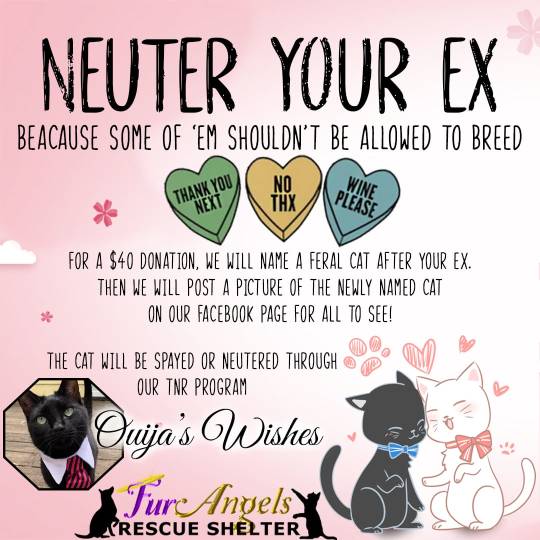
#fur angels rescue shelter#toledo#toledo ohio#adopt#cats#valentines day#spay and neuter#Neuter your ex#ex relationship#Ouijas wishes#donate#save a life#Trap neiter return#Tnr#pets#cute#ohio#fars#adoptdontshop#warrior cats
3 notes
·
View notes
Text
I've been seeing a lot of Discourse around outdoor cats that talks past one of the biggest problems addressing community cats/outdoor working cats so I thought I'd chime in with my two cents.
Many arguments I see just... don't think about the cats at all? Or don't consider the logistics of actually addressing the feral cat problem in a humane way. It's always about how outdoor cats shouldn't be outdoors, which is neither realistic nor helpful.
I used to volunteer at an municipal animal shelter in the USA that had a TNR program (Trap, Neuter, Return) and also adopted out community cats to local farms and businesses. Here's my side of the story.
"Your cat doesn't need to be outside" -- Yes, correct. Your domesticated (non-feral) house cat does not need to go outside at all. They can have a fully actualized life safely indoors. When I see this argument, proponents of indoor only cats are correct in most or all their arguments regarding this.
"Outdoor cats are the largest invasive species in the world, and decimate bird populations." -- This is also correct, and part of the reason why you can help by bringing your house cat indoors. Cats are the largest invasive species. Spay and Neuter your cats, bring them inside, and socialize them so they don't become feral.
"TNR doesn't work." -- False. Whether we like it or not, feral cats exist. We have two methods by which we can address the feral cat population -- decimating them (humanely euthanizing the whole colony) or TNR. For a long time, euthanasia was the preferred way to address the feral cat problem. Afterall, if the cats aren't there, doesn't that save the local wildlife population?
Except that we found, studying these colonies, that when a colony is wiped out, the cats of another colony will spread into their territory and continue to have kittens and the population of feral cats is neither controlled nor diminished.
Hence, TNR. What we found performing TNR on cat colonies was that this controlled the population of the colonies, allowing them to stay in their territory, which kept other colonies from spreading (especially colonies we hadn't performed TNR on yet). We at the shelter felt this was the most humane way to control the feral cat population and safely deflate their existence without dealing with the population blooms that euthanasia caused.
"What about kittens?" -- Kittens from these colonies were brought into the shelter, socialized, and fostered out until they could be adopted. Some of these semi-feral kittens needed special homes to be adopted into, but this was the best quality of life for these cats.
"What about cats that get missed during TNR?" -- We would return to the colony several times over a period of several years to perform TNR on the same colony. We mark cats that have been neutered by clipping their ear (this is done humanely, but is the most reliable way to tell if a cat has been neutered so the poor thing doesn't have to have surgery 3-4 times in their life). Also, during the TNR process the cats would be vaccinated to ensure disease did not spread from the colony (i.e. rabies). Still, even getting 60% of the colony TNR'd would dramatically reduce the number of kittens being added to the colony each year. This controlled the population by allowing the territory to naturally deflate in size over time, buying us time to address the larger feral cat problem.
"What if the colony was in an unsafe location?" -- There were two ways we addressed unsafe colony locations -- remember, we know that when the colony is removed, a new colony will move into its place, so we tried not to move the colony unless we really felt the cats or the public was unsafe -- one was to move the whole colony to a new location. Preferably someplace like a warehouse where we have an agreement with the owners of the warehouse. Some of the cats were even relocated to shelter grounds as our community cats. If the colony was small enough we would bring them into our Feral Cats room and adopt them out as community cats.
"What is a community cat?" -- The way the program worked, was that anyone who needed a working cat could apply to the program. These were often rural farmers or businesses with warehouses that needed rodent protection. We trained the farmers and businesses on how to acclimatize the cats to their new home, and as part of the agreement, they had to care for the cats (veterinary care, vaccinations, food and water). This gave businesses and farms an alternative to expensive and environmentally unfriendly rodent control, and also gave these feral cats good places to live out their natural lives.
"Can't you just adopt out feral cats?" -- No. Cats that have not been socialized around humans as kittens, or who have several generations of feral cat in them could not interact with humans in a way that did not cause them undue stress. This was not a humane way to handle feral cats. However, when a cat was brought into the feral cat room, they would be monitored for up to a week. If the cat displayed signs of being semi-social or fully social (hanging out outside of their den, allowing staff to pet them, showing interest in staff in the room), then we would either move the cat into the adoption room or place them in foster to be socialized before adoption. Feral cats who displayed signs of being able to live full and healthy lives with human companions were NOT adopted out as community cats. We also observed this behavior during TNRs and would do the same for those cats too.
"But aren't cats bad hunters?" -- Compared to other species, cats are not the most effective form of rodent control. This is true. However, you have to understand that feral cats exist. There is no "undo" button we can push to stop them from existing. We have to deal with the problem we have right now, which is to safely and humanely decrease the number of feral cats in our communities. And yes, we do that by using cats as rodent control in the community.
"What can I do?" -- Stop saying community cats shouldn't exist. That's not helpful and doesn't solve the problem we have. Bring your cat indoors. Spay and neuter your cats. Adopt from shelters. Volunteer with a TNR team. Support TNR efforts in your community. Recognize that those of us actively dealing with the community/feral problem are trying to do what is in the best interest of our communities and the animals we love. We aren't sitting over here saying these cats should exist -- a feral cat will not have the same quality of life as one that is indoors with a family -- but we have to address the problem in practical terms. We don't have the moral high ground to just do nothing while pontificating solutions that have no basis in actuality.
And yes, it's okay to celebrate community cats. If your local farm has a couple of working cats, that means that farm is helping participate in the safe deflation of the feral cat population. Don't shame a farm or business for using community cats. We're all doing the best we can to solve the problem that we have.
6K notes
·
View notes
Text
When Friends Help Create Miracles
When friends help make miracles happen.
Several years ago now three cats showed up at my back door. It is not unusual for people to dump animals out here in a rural area. I, being my mother’s daughter and not wanting to see anything go hungry, fed them. They immediately became my cats. I tagged them the three mousketeers and the adventure began. Over time the three became nearly twenty. Cats are…
View On WordPress
#cycle of life#even for cats#feral cat colony#miracles happen#no more babies#spay and neuter#taking care of pets#taking care of the feral population#trap neuter return
1 note
·
View note
Text
Wenatchee Valley Humane Society Addresses Community Cat Programs
New Post has been published on https://petn.ws/R68Ci
Wenatchee Valley Humane Society Addresses Community Cat Programs

Wenatchee Valley Humane Society (WVHS) is addressing their community cat programs following an article that detailed employee concerns over shelter changes. Discussion began back in February, when local investigative journalist Dominick Bonney published an article that discussed the shelter’s Return-to-Home (RTH) policy and their Trap-Neuter-Return (TNR) policy. These policies are part of the shelter’s Neighborhood Cat Project, […]
See full article at https://petn.ws/R68Ci
#CatsNews #AnimalShelter, #Cats, #Feature, #KpqNews, #LocalNews, #NeighborhoodCatProject, #ReturnToHome, #TrapNeuterReturn, #WenatcheeHumaneSociety
#animal shelter#cats#feature#kpq news#Local News#neighborhood cat project#return to home#trap-neuter-return:#wenatchee humane society#Cats News
0 notes
Text
Alley Cat Allies Exposes Misrepresentation of TNR in The New Yorker
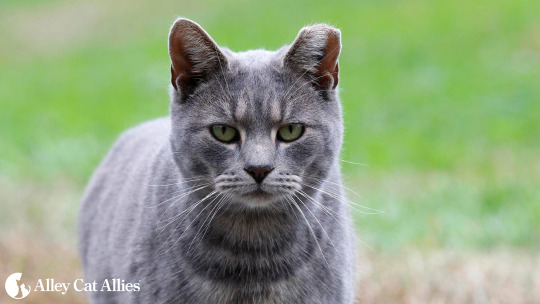
Alley Cat Allies is compelled to address the shockingly biased and dangerously misinformed portrayal of Trap-Neuter-Return (TNR), community cats, and the people who protect them in the piece ‘How the ‘No Kill” Movement Betrays Its Name’ published in The New Yorker.
The “article,” which should be labeled an opinion piece, uses debunked and antiquated studies to advocate for lethal control of cats outdoors, all while desperately downplaying the only humane and effective approach—Trap-Neuter-Return (TNR)—and condescending to or downright insulting the people who do the real legwork to benefit cats and communities.
Writer Jonathan Franzen purports various cynical, imagined reasons why our movement calls unowned cats who live outdoors “community cats.” We’re here to clear the air: Community cats, who live and thrive in their natural outdoor homes among us, are called such to acknowledge their thousands of years of history as members of our communities.
Community cats are bonded to their outdoor homes and to their feline families, and they are not generally candidates for adoption. TNR acknowledges their nature, their biology, and their inherent value as beings deserving of respect and protection by allowing these cats to continue their lives in familiar surroundings while ensuring their population stabilizes.
TNR is the ONLY evidence-based, humane, and effective approach to cats outdoors. Spaying or neutering means fewer kittens born outdoors and the reduction of behaviors associated with mating—which are what people point to as “nuisance” behaviors. Additionally, vaccinations provided during TNR improve the cats’ health and address community health concerns—though it’s critical to note that cats are extremely unlikely to spread rabies, toxoplasmosis, or any other diseases. The success of community TNR programs is studied and documented.
TNR is also the primary way community cats with other medical issues receive the care they need— despite Franzen hammering in the idea that all cats are suffering outdoors (there’s a sinister motive for this, as we’ll describe later), community cats are generally healthy and in good condition and live long and fulfilling lives as pet cats.
Developing objective, science-first best practices aimed at humane care for animals, building peaceful communities, and protecting all species should be the top priority in our modern world. That is why Trap-Neuter-Return (TNR) has become mainstream practice. Beyond saving cats’ lives, TNR is sound public policy that reduces calls to animal control, reduces the number of cats entering shelters, and reduces taxpayer expense, all while meeting the demands of the public for effective, meaningful, AND lifesaving action for cats in their communities.
Franzen writes about TNR as under-resourced in far too many communities. The logical solution would be for local governments to devote more resources to TNR to improve its reach and efficacy rather than continue to waste money on ineffective lethal schemes. Franzen’s conclusion, though, is that lack of resources means TNR will never work. He believes cats should be killed—and his portrayal of cats as constantly suffering outdoors is meant to justify lethal schemes.
TNR opponents’ proposed “alternatives” to TNR come down to rounding up and killing cats over and over and over again. However, trapping cats and “euthanizing” them in shelters is not some untested idea; it was the status quo for decades and failed miserably due to the Vacuum Effect—a phenomenon in which other cats move in to take advantage of the resources that sustained the colony that was removed. In fact, TNR rose from a history of futile, cruel catch-and-kill cycles because communities recognized the need for change and that compassionate and humane approaches worked.
Franzen, like many in the anti-TNR crowd, cites the same piece of debunked junk “science” that keeps coming back to haunt us within so-called “factual” articles. That “science” is an exercise in Olympic gymnast-level contortion to fit the findings of older studies into a pre-determined conclusion that cats are a major threat to birds and other wildlife species.
Cats have an important place in ecosystems, and whenever they are removed in large numbers, the consequences are dire—not just for the cats but for local wildlife. The reality is cats are not a major threat to wildlife species, endangered or otherwise, and the “science” that claims such is heavily flawed and funded by fringe interests and biased parties. As we have seen time and time again, catch and kill leads to nothing but an endless cycle of expensive and morally bankrupt slaughter that does not benefit cats, community, or wildlife.
But, on a positive note, the reality is also that we can protect both cats and wildlife. The interests are not mutually exclusive. By advocating for stronger TNR programs backed by local governments AND policies that curb human-led activities that are the true threats to wildlife—like habitat destruction and pollution—we improve the lives of cats, wildlife, and us all.
Like all worthwhile goals, communitywide effort is the key to humane and effective programs and policies. Rather than condescending and stereotyping cat caregivers, as Franzen does repeatedly in his article, Alley Cat Allies supports them with humane education on best practices for TNR and community cat care. Rather than give community leaders an excuse to give up on humane programs and utilize taxpayer dollars on an endless cycle of killing cats, we push them to work WITH members of their communities and allot funds to what their people believe in—which overwhelmingly is non-lethal approaches.
It’s time for communities, local governments, and media outlets like The New Yorker to stop wasting words, space, money, and time on calls to backtrack to the dark ages of killing cats and kittens endlessly. TNR is the only way forward.
Content source: https://www.alleycat.org/alley-cat-allies-exposes-misrepresentation-of-tnr-in-the-new-yorker/
#Trap-Neuter-Return#TNR Misrepresentation#The New Yorker Article#Cat Care Insights#Cat Rescue Awareness
0 notes
Note
mr j, in the US trap neuter return (TNR) programs will clip the ears of strays to mark that theyve been TNR'd... do you do something like that in japan?
It's same, isn't it?

721 notes
·
View notes
Text
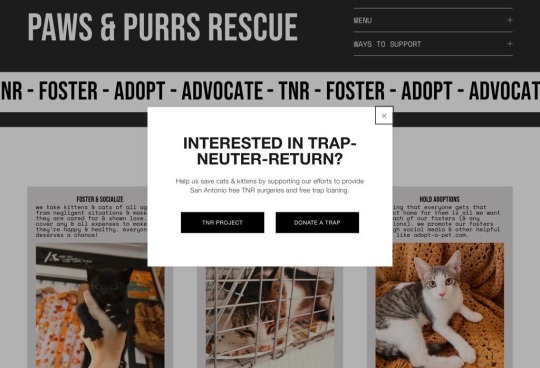
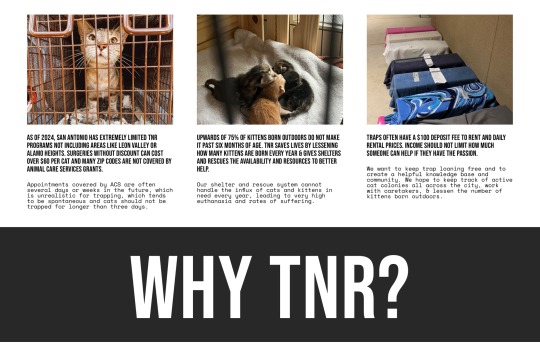
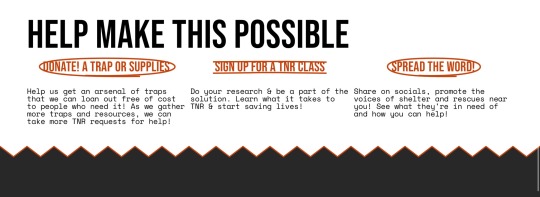
gave our rescue site a huge make over! :- ) along with finally finishing up our tnr area where people can learn everything they need!
10 notes
·
View notes
Text
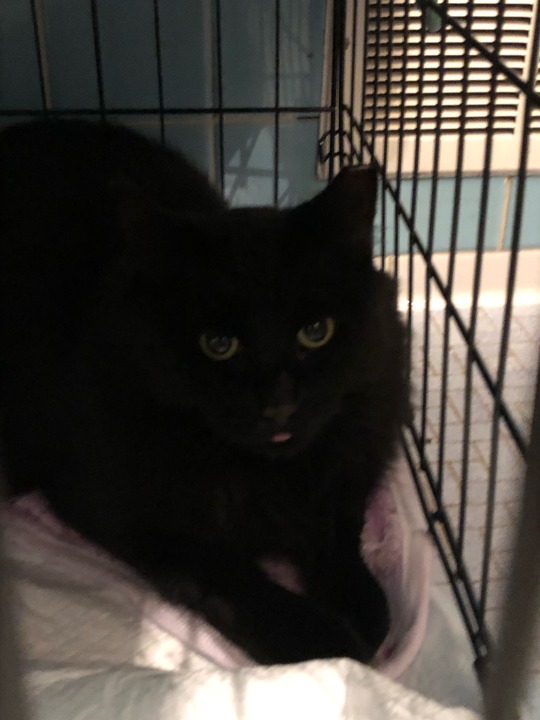
She got spayed and ear-tipped today.
1 note
·
View note
Note
sorry if I’m just out of the loop, but why would we turn off kits for Cinnamon?
You're fine! The reason we'd turn off kits for Cinnamonpaw specifically is that he has a clipped ear, which cats in real life are typically given after they've been through the TNVR program (Trap, Neuter, Vaccinate, Return). So pretty much just to keep in continuity with that!
The only reason he hasn't been returned yet is because the people that caught him aren't exactly hyped to be putting him back in Fungus Land, and so someone decided to try to take him in instead.

Oh, ALL the time. He does nothing but give me prompts like this




#chitchat#ask#he is literally SO UPSET at all times ive never seen anything like it#worlds most miserable kitty cat
86 notes
·
View notes
Text

don’t have the energy to draw out the AU rn but take this!!
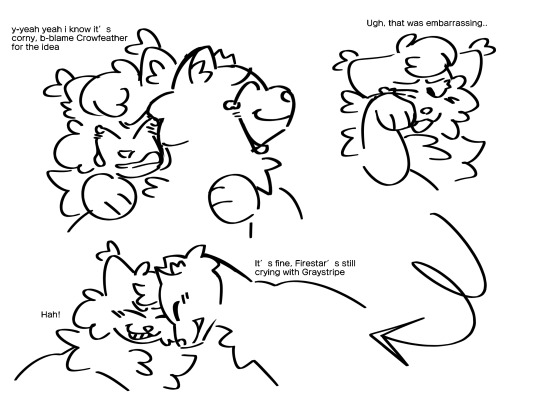
reunion :) idk Shrew and Squirrel have such wlw mlm solidarity vibes to me like idk. they have a very cute relationship whether it’s romantic, qpr, or just besties, i love them :)
AU stuff :)
iiin this au, Shrewpaw caught the pheasant, but was still in the way of the construction vehicle and was very badly injured. He was named a warrior early, given the name Shrewflight, in honor of the pheasant he leapt for before it could fly away, bringing it home to feed his clanmates in a time of great need. He wasn’t well enough to make the journey, but the elders that stayed behind swore they’d care for him as best they could. He was young and strong, they encouraged him every step of the way, even after his clan had left no choice but to leave them all behind.
Eventually, the cats grew desperate, and the traps the construction crew left out made quick work of scooping them up. They were a bunch of hungry elderly cats and one who was very injured, it wasn’t all too hard to catch them. They were brought to the local shelter in… whatever town the forest is near. Shrewflight was brought to a vet where, unfortunately, his leg had to be amputated as the elders, while they tried their best, really didn’t have the medical experience to care for him correctly.
In the town’s shelter, lo and behold, GRAYSTRIPE!?!? and Millie, hi, nice to meet you. aaanyway gray is very happy to see his clanmates, but also mortified to hear what has become of their old home. The elders still have to stay behind, they can’t make the journey, but Shrewflight is determined to accompany Graystripe and Millie, and the trio escape the shelter and make their way to the clans
Squirrelflight chose to be named after Shrewflight in this AU, similar to how Crowfeather chose to be named after Feathertail!!
Also the vets neutered Shrewpaw just to kill two bird w one stone in surgery, that’s why his ear is tipped! This causes a lot of drama when Squirrelflight returns to the clan with 3 kittens in tow, and chooses to settle down with Shrew…
Also i adore the contrast between Shrewflight and Spiderleg in this AU, how Shrew committed himself to someone he cared deeply for, and took in kits that weren’t his as if they were his own, meanwhile Spiderleg cut himself off from the one he used to love and abandoned his own children.
132 notes
·
View notes
Text
i accidentally deleted the anon that said parisians should start a trap-neuter-return campaign for chat noir and i’ve never been more devastated. idk who you are but that’s fucking hilarious.
720 notes
·
View notes
